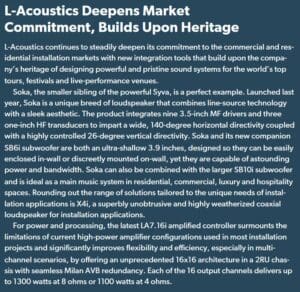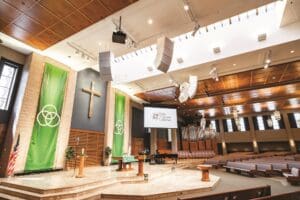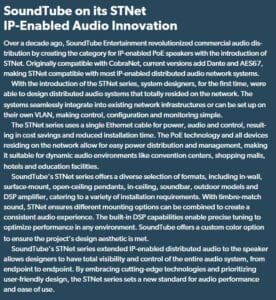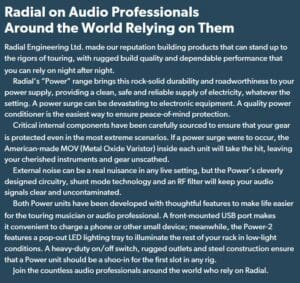This month, Commercial Integrator debuts a new Deep Dive focusing on an area that we, as a publication, intend to cover even more robustly than in years past — namely, performance audio. We choose the term “performance audio” not necessarily to refer to musical or theatrical performances, but, rather, to emphasize our intent to spotlight high-performance audio applications and the technologies that power them. So, in the pages ahead, you can look forward to reading about line arrays, audio-over-IP, wireless systems, immersive audio and much more, all while gaining fresh insight into the strengths and weaknesses of various verticals. Moreover, we’ll analyze the latest supply-chain considerations for the performance-audio category.
As we always do for CI Deep Dives, we have gathered an incredible group of subject-matter experts: David “DJ” Kawczynski, CTS, system commissioner and audio SME, IMS Technology Services; Scott Wright, owner, Lifeline Audio Video Technologies; Ryan Peavey, CTS, systems design and sales, Clearwing Systems Integration; Charlie Salto, project engineer, AVI-SPL; John Richards, CTS, director of engineering, AVI-SPL; Jared Timmins, vice president innovation, Diversified; Justo Gutierrez, director of engineering, media, Diversified; Bobby Bernard, senior vice president, supply chain and procurement, Diversified; and Sean Wargo, vice president, market intelligence, AVIXA.
Backdrop
By now, it might seem passé to contextualize every conversation around the pandemic, but it seems worthwhile here. As Wargo notes, “What we all know, and have to obviously start with, is that this category, in particular, was the most significantly impacted by the pandemic.” With concerts and similar in-person activities coming to a halt in March 2020, the declines were simply massive. Equally importantly, the rebound was far from instantaneous. He continues, “I’d say even the last eight to 10 months [is when] we saw a lot of meaningful recovery.” That said, the recovery does now seem quite meaningful, which makes the timing of this Deep Dive report ideal.
Indeed, Wargo points to a recent AVIXA end-user demand study that revealed the ascendance of the “venues and events” market category. “[It] pops right up to the top of the list in terms of renewed capital-expenditure plans, capital-improvement plans, associated budgets and allocations to AV,” he states. “And when you look at what’s at the top of their list, it’s audio.” In fact, AVIXA research forecasts the “venues and events” category to be the fastest-growing market for commercial AV from ’22 to ’27, achieving an anticipated compound annual growth rate of about 9%. To contextualize that forecast, Wargo adds, “The average for the industry is closer to 5% to 6%.”

Increasingly, venues are incorporating cutting-edge audio technology, such as immersive sound systems, advanced acoustics and audio analytics, to create an immersive and engage experience for audience members. Photo courtesy of Diversified.
Examining Performance-Audio Gear
When asked about demand for various audio products and technologies, our integrator interviewees echo much of Wargo’s analysis. For example, Lifeline’s Wright points to line-array sales — both standard and steerable line arrays — as an engine driving increased business with churches and auditoriums. “We had many customers considering purchasing new systems in 2020, and, with COVID-19, that got put on hold,” he relates. “Fast forward three years later [and] the need/want/desire has not gone away.” Theaters and churches want to seize on people’s craving to get out of their homes, and they’re willing to make those deferred technology investments to do it. Kawczynski likewise points to column line arrays and digitally steerable line arrays as recent areas of strength for IMS Technology Services. He cites Community and Renkus-Heinz as among those he has lately spec’d most frequently.
Clearwing’s Peavey underlines the demand ramp up, pointing to three particularly strong product categories. “The desire for robust wireless systems, including microphones, in-ear monitoring and intercom, has certainly grown since the pandemic has subsided,” he observes. AVI-SPL’s Salto doubles down on wireless, saying wireless microphones are a component of nearly every corporate training room or multi-purpose space — anywhere that presenters must address large groups of people. “Even in audio systems supported by ceiling speakers, some level of voice-lift is desired,” he says. “And a worn or held wireless microphone is often the best way to achieve this.” And regarding intercoms, the tragic threats our children face at school are spurring investment. “There is grant money available to improve school security, and intercom systems are driving some of the interest,” Wright notes, pointing to schools whose 30-plus-year-old systems desperately need updating.
Vertical-Market Opportunities
Our interviewees’ focus on corporate and education applications might stick out in the context of a Deep Dive centering on performance audio. But, in fact, those two vertical markets appear to be ideal targets for integrators’ sales teams. Salto points to the education market evincing a healthy increase over the past two years. He remarks, “Many schools had initiatives to accommodate hybrid/virtual classes into their existing classrooms in the form of adding power amps, loudspeakers and microphones to support videoconferencing in the room.” Meanwhile, Kawczynski says that these verticals now present projects “…calling for a higher level of intense sound.” He adds, “We’ve had projects in each vertical for productions studios, listening rooms, and indoor and outdoor athletic facilities.”
 Many corporate clients view performance-audio technology as a facilitator to assist in their return-to-office initiatives, Salto observes. “And not just in the form of typical conference room and training room AV systems we might be used to,” he states. “Having audio products support open areas — an office lobby or lunchroom — may [help] support a large-scale town-hall meeting.” That would likely entail bringing in wireless microphones and a mixing console, which could be used with installed loudspeakers otherwise used for background music. But integrators oughtn’t to overlook the profit potential associated with conference rooms, either. “I feel the conference-room market will remain strong in the next 12 months while businesses continue to find the right blend of work from home versus [work] in the office,” Wright opines.
Many corporate clients view performance-audio technology as a facilitator to assist in their return-to-office initiatives, Salto observes. “And not just in the form of typical conference room and training room AV systems we might be used to,” he states. “Having audio products support open areas — an office lobby or lunchroom — may [help] support a large-scale town-hall meeting.” That would likely entail bringing in wireless microphones and a mixing console, which could be used with installed loudspeakers otherwise used for background music. But integrators oughtn’t to overlook the profit potential associated with conference rooms, either. “I feel the conference-room market will remain strong in the next 12 months while businesses continue to find the right blend of work from home versus [work] in the office,” Wright opines.
Diversified’s Timmins shifts the vertical-market conversation to the ever-increasing popularity of smart venues; in particular, he highlights sports, faith and performance venues. “These venues incorporate cutting-edge audio technology, such as immersive sound systems, advanced acoustics and audio analytics, to create an immersive and engaging experience for the audience,” Timmins enthuses. He highlights evolving capabilities for adjusting audio settings in real time and customizing audio experiences for different events. “From providing crisp audio during high-energy sports events to delivering crystal-clear audio during religious services, smart venues offer a unique audio experience that leaves a lasting impression on attendees,” Timmins declares.
The opportunity in the worship market seems worth underscoring; indeed, Peavey says that he has seen the church market produce the greatest demand as of late. “The pandemic put many church projects on hold,” he acknowledges. “Now that the world is returning to normal, those projects have kicked up again.” And, of course, potential parishioners are looking for an experience beyond what they can get streaming on YouTube or Facebook.
Dollars and Cents
Drawing on AVIXA’s market-research data, Wargo paints a rosy picture with regard to integrator revenue flowing from performance-audio products and technologies. “The relevant solution area for what we’re discussing here would be performance/entertainment,” Wargo explains. “We expect that compound annual growth rate to be 8%.” That high-single-digit CAGR can’t be too surprising, as much of the excess savings that people accumulated during the pandemic is now flowing into verticals that leverage performance audio to deliver outstanding experiences. “There’s been good revenue flowing into the markets that would be buying those fixed-installation solutions,” he opines.

According to Lifeline’s Wright, line-array sales — both for standard and for steerable line arrays — have been an engine driving more business with churches and auditoriums. Photo courtesy of Clearwings System Integration.
Wright pinpoints performance audio as a category whose profit potential and margin level exceed that of video. “Performance-audio systems are typically ‘solutions,’” he observes. “You’re not just buying displays or products that can easily be purchased on the internet. Customers are buying complete solutions that include installation, programming, maintenance contracts, etc. Whenever we can offer a solution sale versus a product sale, there is more profit.” Kawczynski amplifies the point about performance audio’s profitability. He says, “We’ve done very well on these projects. The revenue streams on these projects, [apart] from other categories, are slightly higher.”
But that’s certainly not to say that this category has been immune to systemic logistical challenges. AVI-SPL’s Richards describes it clearly, pointing to longstanding supply-chain issues that have only seen recovery in the past several months. “Wireless microphones in general have been a large struggle and continue to have longer lead times,” he states. Compounding the problem was the shortage of Dante chips. “We are now seeing product revisions and backlogs clear up,” Richards says hopefully, “but the past year has seen a lot of challenges across the board.” Peavey brings the conversation around to relationships, saying that having the right ones can prove make or break. “It’s difficult to procure system components for performance-audio systems without a relationship with the manufacturers that clients desire,” he says. “Unless those relationships are in place, margins will be tight.”
Considering Audio-over-IP
These days, we often say that the AV industry is network-centered to a degree far beyond even a few years ago. Our interviewees say this trend certainly applies to performance-audio technology. “Virtually every manufacturer has an audio-over-IP offering, and cross compatibility has been improving steadily,” Peavey notes. “Nearly every system we design/install has a networking component, whether that be Dante, AVB or Q-LAN, and there is a method to convert between these, or to AES and analog, allowing the integration of these protocols to be straightforward and economically viable across all project sizes.”
 Peavey adds that, unlike the VHS versus Betamax war, he expects no single solution to ultimately win. “Dante and AVB each provide a solid solution,” he declares. “So, it is difficult to see either disappearing in lieu of the other.” Kawczynski seems to agree that there’s room for both. “I currently find Dante and AVB to be very effective digital audio protocols [that] satisfy many of our clients’ requirements and needs,” he explains. Many manufacturers have widely adopted both protocols, he says. Moreover, both offer good training, software and support.
Peavey adds that, unlike the VHS versus Betamax war, he expects no single solution to ultimately win. “Dante and AVB each provide a solid solution,” he declares. “So, it is difficult to see either disappearing in lieu of the other.” Kawczynski seems to agree that there’s room for both. “I currently find Dante and AVB to be very effective digital audio protocols [that] satisfy many of our clients’ requirements and needs,” he explains. Many manufacturers have widely adopted both protocols, he says. Moreover, both offer good training, software and support.
But it’s important not to overlook Q-LAN, which, according to Diversified’s Gutierrez, is particularly well suited to sports-facility projects, which represent a real area of strength for Diversified. “Diversified relies mostly on QSC Q-LAN (on their Q-SYS platform) and/or Dante, depending on the use case,” he comments. “For sports facilities, Q-SYS is the de-facto DSP solution on the market today, and either Q-LAN or Dante are the protocols that work best for audio distribution around venues.”
As goes without saying, Dante does continue to be a large part of any AV-over-IP conversation. “Dante is everywhere now,” Salto emphasizes, “and there is almost always a requirement to support it.” Naturally, he says, AVI-SPL works with manufacturers that utilize their own proprietary or more uncommon network-audio transport protocols. However, he adds, “…we still go with the ones who support Dante in addition to their own network audio protocol.” Salto cites QSC and Biamp as having their preferred protocols but still fully supporting Dante in the same network environment. Wright buttresses that point, saying, “It’s rare that a piece of quality technology designed today can’t integrate with Dante. Since the integration is available, we look at most projects and determine if using Dante is the right solution.”
Wireless-Mic Considerations
As someone who has been covering performance-audio technologies since 2004, I’ve borne witness to very considerable constrainment of the RF spectrum for wireless-mic users. So, CI now quizzes our interviewees on how big of a problem this continues to be. Peavey credits our industry with adapting to the challenge quite well. “Innovation on the part of the larger players provided the solutions to keep our industry headed in a stable direction,” he states. “The development of frequency hopping, then digital wireless helped the industry utilize the available white spaces more efficiently.” Pointing to wireless platforms that can handle 40-plus channels in a 6MHz sliver of the spectrum, as well as equidistant tuning without intermod calculations, Peavey adds, “…deployment of large wireless systems has become less of a chore than in the past.” He also cites the salutary effect of manufacturers increasingly exploring the 1.9GHz, 2.4GHz and 5GHz bands.
Kawczynski concedes that a few factors — namely, the lack of frequency ranges reserved exclusively for wireless microphones and variable region-to-region regulatory requirements — can make frequency coordination a bit tricky. “We rely on many of the free RF-analysis software tools, provided by companies like Shure, to coordinate our wireless frequencies,” he states. He cites the particularly challenging nature of large-city deployments, saying, “… [these] generally require more scanning time throughout the day to make sure a nearby venue doesn’t turn on their wireless at a particular time of day, causing interference.” Salto picks up the point, offering, “My favorite version of this is in Shure’s MXW line, where you can bring one of their MXWAPT devices to a site and run a scan. [It will tell] you how many channels can be expected to run simultaneously without any interference.”
Immersive Audio Gains Attention
If audio is going to be a magnetic force attracting people to theaters, auditoriums, theme parks, museums and other venues, the latest advances in immersive-audio technology might prove indispensable. Richards believes in the vision, saying, “Immersive audio is often driven by experience-driven spaces and can be seen as a requirement even in purpose-built briefing/experience centers.” Quite often, AVI-SPL’s Experience Technology Group (XTG) engages with spaces that require performance visual and audio experiences that naturally immerse participants in the client’s vision and story. “While the solution may not be the highest output or a large venue, the channel counts and directionality of the audio can become very important with performance purpose-built solutions,” Richards explains.
Related: A Tool for Every Modern Integrator’s Toolbox
Peavey also embraces immersive audio’s potential but likewise is clear-eyed about the challenges. “Immersive audio is certainly making a strong case for its usefulness in large-scale productions,” he enthuses, but adds that project stakeholders must be ready for “…budgets [that] allow for the additional order of magnitude in equipment requirements.” Given that some technology enthusiasts expended their pandemic-era excess savings to level up their home theaters and video-gaming setups, client desire exists in many cases to replicate — and exceed! — the soundscapes they’ve come to love. “There is a completely new way of thinking when it comes to mixing in an immersive space that can be difficult to master,” Peavey remarks. “With consumer-level tools like L-ISA Studio from L-Acoustics and the Dolby Atmos Renderer, I fully expect immersive mixing to become more widely understood and the large-scale systems to be more seriously considered options.”

If audio is going to be a magnetic force to entice people to visit theatres, audiotoriums and other attractions, the latest advances in immersive-audio technology might prove indispensable. When combined with dazzling video, it delivers incredible experiences. Photo courtesy of Diversified.
Others among our integration experts have a more equivocal view of immersive audio’s potential. For example, Kawczynski’s firm, IMS Technology Services, which focuses heavily on conference and collaborative environments, hasn’t had any specific requests for immersive-audio deployments in those spaces. While emphasizing that he’s open to future applications, Kawczynski articulates the view “…that immersive audio seems better suited for specialized applications, such as attractions and themed environments.” Wright concurs, saying very few of Lifeline’s clients ever ask about immersive audio. “Most of our clients struggle to operate a digital mixing board without extensive training,” he acknowledges candidly. “[That] means using immersive audio would require a level of knowledge that most of my customers simply do not have.” Thus, it’s not merely budgets that might inhibit this category’s flourishing but also client comfort with the underlying technical complexity.
Performance Audio Challenges and Strategies
Although, clearly, our integration experts disagree in some of their viewpoints, all of them are on the same page as regards the principal challenges integrators working in the performance-audio category face. Gutierrez sums it up well, saying, “Component availability and lead times have been the single greatest limiting factor in our ability to execute projects over the past year.” Peavey amplifies the point, describing the supply chain as “a constant battle” emerging from overheated demand clashing with limited availability. “We still have orders 12 months or older that have yet to be fulfilled, and clients are begrudgingly willing to wait,” he attests. Thankfully for Clearwing, the company embraced a proactive strategy as the world began to reopen. “[We placed] large strategic orders…for some of the higher-demand/longer-lead-time items, like wireless microphones and loudspeaker systems from in-demand manufacturers,” he explains.
 Another popular strategy is to nimbly redesign projects to utilize the products and technologies that are available. “We’ve had countless projects where the final equipment selection was made solely based on what product would arrive in time to make the project’s schedule,” Salto confirms. “And many of those projects went through multiple re-designs to get there.” Clearly, integrators that are untethered to any specific manufacturer’s supply chain are in a more advantageous position, although that nimbleness carries associated responsibility. “As integrators, we need to keep ourselves well versed in products from all our available manufacturers,” Salto advises. “Many customers are impartial to what brand of power amp is in their equipment rack. They just need it to work, and they need it to arrive on time.”
Another popular strategy is to nimbly redesign projects to utilize the products and technologies that are available. “We’ve had countless projects where the final equipment selection was made solely based on what product would arrive in time to make the project’s schedule,” Salto confirms. “And many of those projects went through multiple re-designs to get there.” Clearly, integrators that are untethered to any specific manufacturer’s supply chain are in a more advantageous position, although that nimbleness carries associated responsibility. “As integrators, we need to keep ourselves well versed in products from all our available manufacturers,” Salto advises. “Many customers are impartial to what brand of power amp is in their equipment rack. They just need it to work, and they need it to arrive on time.”
Wright makes the salient point that supply-chain issues haven’t affected only our industry but also the construction industry broadly. “There was not a single renovation/construction project that was on schedule the past 12 months,” he laments. Rather than just allowing these exogenous forces to buffet his company, Wright chooses to act. “One change we made was being more aware of billable products for new construction and asking for larger down payments for design/build projects,” he explains.
Ultimately, Wright says, “Cash has never been more important in business than it is today. There is nothing more frustrating than not being able to complete a $100,000 project because of a $150 card that’s not available or on back order for eight months.” Wright has effectively mitigated that risk by “…[working] with customers on payments that made sense for all of us.” That’s a lesson that CI and our organizational partner NSCA have tried to impart in recent months.
In Conclusion
Supply-chain issues remain unresolved, although there might be light at the end of the tunnel. According to Diversified’s Bernard, “We see those pressures easing this year as manufacturing capacities have improved, sourcing has shifted and logistic constraints have been mitigated.” In fact, he forecasts that “…all the remaining [categories] will have significantly improved lead times by the end of 2023.” If that’s the case, the performance-audio market will cut loose one significant anchor that has weighed it down. Other risks do exist, however, including the probability of a shallow recession in the next 12 months, as well as ongoing inflation that has manifested in vendor price changes that, in some cases, seemingly occur on a near-monthly basis. It takes a hearty constitution to work as an AV integrator, and the last few years have proven that truism.
But yet, the performance-audio market offers so much profitability potential, as well as the opportunity to deliver the kinds of experiences that exhilarate and inspire us all. What’s more, when integrators embrace more technologically advanced applications, such as immersive audio, digitally steerable line arrays and others, it empowers those firms to sell their expertise first and foremost. And that’s the foundation of a solutions-driven relationship. “I look at our company as a solutions provider,” Wright concludes. “We take complex technology and make it easy to use. We build relationships.” And when the fruit of the relationship is a dazzling audio experience that attracts visitors and touches their hearts…well…that’s just the cherry on top.










